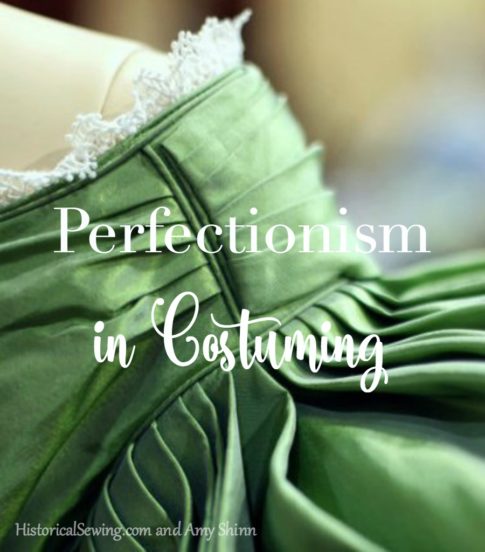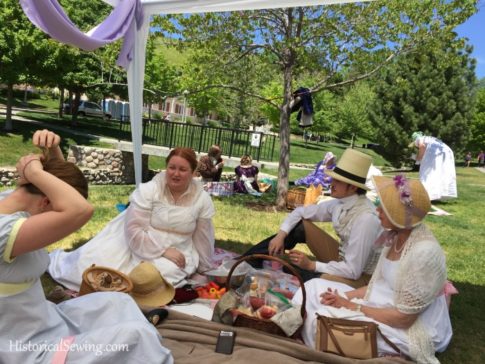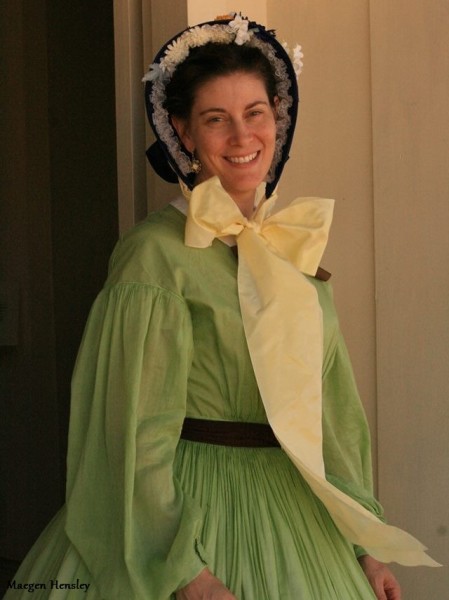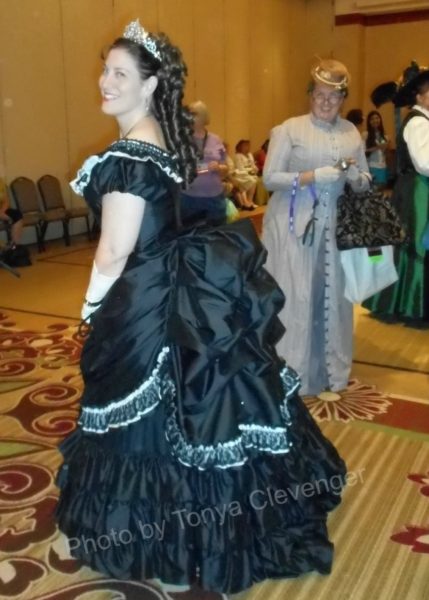
This post was first published in November 2017. With all the crazy happenings of 2020 and 2021 within our community I thought it good to take a look at this topic again.
Being perfect. What does that mean? When you strive for “perfect” you nearly always fall short of it. As one of my mentors once said, “it’s only after a project is complete that you can look back and say, ‘Wow! That came out perfect.'”
Perfect: having all the required or desirable elements, qualities, or characteristics; as good as it is possible to be; faultless; flawless; completely free from faults or defects.
Perfectionism: refusal to accept any standard short of perfection
When talking about a costuming project, perfectionism is overrated. I mean, we’re dealing with garments to wear. Clothing. Varying skill levels. Budget issues.
Somehow, in the modern historical costuming community being perfect has become a “thing,” especially recently.
That if, oh, dear, you are sewing at six stitches an inch it’s therefore wrong because it should be 10 per inch.
Or if you naturally look a particular way you shouldn’t be wearing XYZ styles.
Or because your husband got laid off leaving you with only a few bucks for a new dress and the poly taffeta is your best option…. and you are getting bashed for it….
Lately, and quite unfortunately, I’m hearing more of bullying in our costuming groups. This saddens me. And a lot of it stems from having a “holier than thou” attitude and bringing perfectionism into the conversation…. at least what perfection means to those people commenting about someone else’s work.
Listen, I’ve said for years that costuming keeps us dreaming and stomping on someone else’s dream and creativity is no way to advance the art and keep it alive.
Those of us who create historical garments have a variety of goals as distinct as each person in our small community. The path is different and varied for all. We connect to each other in the general sense of wanting to produce garments and accessories based on historical fashion. HOW we go about it, and to what level of detail, is what makes us different and colors this hobby in a myriad of ways.

Some may only need a dress for the upcoming picnic so they don’t look out of place. They have no desire or need to wear it later.
Others want some historical accuracy but are restrained by time and/or budget considerations, so shortcuts are necessary.
Yet still others want to delve into the WHY behind the sewing techniques and methods used by our ancestors.
Then there are the scholars who not only want to research it all about a particular garment or era but also want to reproduce items as close as possible to the originals.
EACH AND EVERY ONE OF THESE VIEWPOINTS IS VALID AND NECESSARY IN OUR COMMUNITY. No one is wrong in their chosen path.
Your goal is different from mine. The why I do something is just as important as your why.
Every now and again our paths may cross to travel the same road in trying to achieve similar results. Yet, your path will vary greatly from mine. And this is not wrong. It’s what makes us individually unique and connect to our humanity.
But don’t bring your perfectionism into my world when you think I’m doing something that’s “not what they did.” Sure, there are good and bad choices, but that doesn’t make them incorrect when we are talking about a creative endeavor.

Historical costuming is creative from YOUR personal point of view. We each bring our modern, 21st century ideals and thoughts along with current skills and knowledge into each project we work on. We learn as we go. Our minds are opened to new ideas and methods as they are presented to us on our path.
It’s sad that one’s perfectionism – that turns into bullying – ignites the need to knock another’s creative work because they “know” how it’s supposed to be or look like when it could be that that other person is simply quite happy with their work.
There’s room for all of us in this sewing community. We NEED everyone here to share their knowledge, their works, their skills.
But don’t let it get to you if I don’t use your detailed research on how to make a Victorian bodice when I’ve found a better way – for me – in using other techniques. There’s no reason to bash my use of a serger because it’s not your perfect way of sewing Victorian garments.
Let’s keep “perfect” out of the conversation.
Allowing others the freedom to pursue their individual goals is thoughtful and caring. What makes this community Joyful.
In other words, let’s not push what we individually consider the “perfect” technique onto someone else. There’s many ways to produce results when re-creating historical clothing. Instead, let’s encourage others from where they are today on their journey!
Together we make this creative hobby fun and welcoming to newcomers. We are responsible for sharing and encouraging the next generation to take up where we have left off. And bullying has no place here.

I’ll be frank and open. As someone who “wants the pretty dress” and teaches others the basics of historical sewing so they can have their pretty dress too, I will continue to move forward with promoting good things that come into our community that are beneficial to others – be it a book, a pattern, new research, a blog post, whatever.
I will support others’ creative projects that are based on historical fashion whether they are hand sewn stays, a machine embroidered Titanic gown, or a Steampunk wardrobe.
Plain and simple: I am not, primarily, a researcher, a scholar, or one who is trying to find out “exactly” how our ancestors made their clothing. I study originals enough to then use my talent of engineering to teach others how to do it. I don’t want to teach at the level of perfectionism. Because most people today don’t want to or don’t have time to make things exactly like they did.)
I want people to sew and make things! To create that pretty dress. To be inspired. Darn it all if it’s not historically accurate! That’s not the path I’m on. Life is too short.
However, you may be on that path – great! I’ll leave the detailed research to others and for those people who want to delve more into the studying I don’t care to do. To those who actually care about counting the stitches – which is still a super valid point of view.
As you move forward on your own journey be careful in thinking your research is the “be all and end all” way of making historical garments. THAT is the perfectionism I’m talking about. And we don’t need that here.
You do what you feel is the best for creative journey and I’ll follow my path. Together we can make the world a prettier place!
Cheers, my friends!
~Jennifer 🙂


Hoi
Ik vindt het geweldig wat je maakt
Zonden dat mijn engels niet zo goed is en dat ik het niet allemaal begrijp met lezen
Top groetjes uit nederland
Merci Jennifer, c’est un article plein de sagesse et de bon sens que je ne manquerai pas de relire lorsque je suis dans le doute….Ce qui est le cas pour l’instant.
Nos ancêtres ont fait avec leurs moyens, avec leurs connaissances et leurs limites…A nous de faire de même!
Dominique
from Belgium
I LOVE this!!! Thank you (: I LOVE seeing peoples’ twists on historical fashions and re interpretations of different styles. Thank you for supporting other creatives!
You’re welcome! They are so fun to mish-mash.
As someone who is brand spanking new to creating garments (I have made a grand total of 1 modern skirt, full of glorious and obvious mistakes…I mean learnt lessons), and wanting the pretty dresses and skirts, but living in a very hot and humid climate, not wanting to wear anything other than cotton and linen (because dry cleaning is not practical for me), even reading these supportive words about our own journeys is very encouraging to me. I have stumbled down into this rabbit hole through YouTube, and am enjoying the journey thus far.
Welcome to our Joyful Community, Gwen!
Looking at the V&A books and collections irl, and a LOT of other books and close ups of original outfits my biggest takeaway is that even the creme de la creme of real life outfits, from history, were rarely ‘perfect’. When you consider that mot of these are either special occasion, or origianlly owned by people who could afford to store these away (as opposed to recycle endlessly) then it is amazing (t our modern eyes) how imperfect these are. There is piecing, pattern mismatching, wonky seams – the list is endless, and yet these are items belonging to wealth people. Is our obsession with perfect the result of growing up with mass-produced items of clothing which don’t involve us in the day to day drudgery (because if we don’t do this for fun it is yet another job)? I love the fact you can see day dresses with obvious darts on the out side, exposed seams insie and piecing displayed for all to see. This is what is ‘real’ and perfection isn’t necessarily historically accurate (even if to our eyesit is the only acceptable way to go).
Also we don’t appreciate, I think, the fact that some of us (myself included) have never sewn a seam before in our lives, let alone a garment and there IS a snobbery prevalent in the community where, if you aren’t great at sewing you shouldn’t even consider trying this out. I got it a lot with medieval reenactment and see it all the time with the regency/etc., communities. I do believe there should be more pins out there of less than great outfits because otherwise we are going to frighten off people who want to do this but are totally intimidated by the elitism running rampant in sewist circles
Fantastic comment. Yes indeed that it was merely their clothing. It was garments of real life.
I mention some of this in my post on duplicating antique garments.
Sarah you are absolutely correct. We all need to accept that we are not perfect beings. Imperfection cannot create perfection. We all just do our best with the gifts, and challenges we possess. I have been sewing costumes since I was seven years old. I am almost 64 now. I remember BEFORE the internet, when extensive research was not possible for the average person. I look back on what I made and I cringe, until I remember I was poor, uneducated, and self taught.
Thank you for voicing this – it was one of the reasons I DID NOT get involved with some groups – snobby seams! I am an excellent seamstress but found some of these people ridiculous – not everyone can afford 9 yards of silk!
Thank you! This bashing of others is so detrimental; no discussion and/or learning can take place when you’re the recipient of someone’s snarky remarks. I work in a history park and we no longer host certain events because of the snide comments directed at us as well as other guests. Sometimes it has felt the only reason some people attend is to find a target for their disdain.
How sad to not host events because of rude behavior!
Thank you! I’m a firm believer that our foremothers would have striven for the newest and easiest way to construct a garment; that there is no true “historical accuracy”. We have the luxury to copy their ways, but they’d have wanted our best machines and materials.
Hi Jennifer,
First, I’d like to say I stumbled on your post while browsing and found it delightful to read and learn. I have been a collector of vintage dresses and gowns from 1850’s through the 1960’s. I started making Scarlett;’s green drapery dress a few years go, and had to stop. When I picked it up again last year to finish it, I combined modern sewing techniques and some authentic methods as well. I flat lined the waist, didn’t do the skirt as it was a heavy velvet, but the underskirt, I cut the 4 front panels of velvet and the back panels of polished cotton to save fabric and weight. lots of hand sewing and overcasting all seams, phew! It came out fantastic! Thank you again for all the information you share. I certainly learned a few things today that I didn’t know.
Glad the post was helpful! Thanks for reading and commenting, John. Cheers!
I have sewn historical garments for theatrical use. I have quit following certain groups and individuals because I felt that they engaged in a type of bullying behavior I find worse than some of the teenage online bullying i have seen. Thank you for this. I don’t have the time nor the he need to be « perfect ». I am human and I sew for pleasure. I like it a bit imperfect just like me. I also have taught beginners to sew. Encouragement and gentleness go a very long way in education.
I am so thankful for your writing on perfection in historical clothing construction. I echo your point of view. If it discourages anyone from “an except, but, next time you should”comment you shall forever be my heroine.
Thank you for your article. My daughter do quite a bit of sewing for CominCon style conventions and the range is from obviously hastily put together outfits to truly remarkable ensembles. What I love is the support that comes from everyone, the ametures are complemented and encouraged as well as the awe inspiring ones that everyone wants pics if. Keep encouraging people, and just have fun, after all, isn’t that why we do this?
Exactly why we do this! <3
Wonderfull article. I just want to have fun and have something authentic but with a Twist. I like to bead and embroider and use Jewels so that is what I do!
Sparkles! Fantastic. 🙂
When I made my Dickens Festival dress, I used lilac moire taffeta and black lace from the shop where I worked
. Yes it was polyester not silk but heck the colours were right (l was doing 1840s ish half mourning) and the dress looked fine. The bonnet is more a case of work in progress…
I keep my underpinnings modern as l can’t handle the idea of corsets and I used hard net and a recycled taffeta skirt to puff out the dress skirt but it worked!!!!! If I am sewing for customers I will do the hoops etc for myself due to lack of time and enthusiasm at one point it got a bit last minute. Still l got several compliments, so can’t be bad. Latest one is an 1890s inspired dress with the big leg of mutton sleeves that was meant to be for the Christmas Dickens Festival, but has ended up being worn as a normal winter dress as l find it very becoming and easy to wear providing I am a bit careful getting on and off buses etc. I would add some of us like fashion inspired by the past but don’t want all the corsets etc but love the styles and interpret them to suit ourselves. And now the Costume designer of the film ” the Favourite” has revealed her take on the fashions of Queen Anne’s time, which look amazing I feel there is room for all sorts of skill levels, approaches etc and why not use modern fabrics etc if they give you the look you want